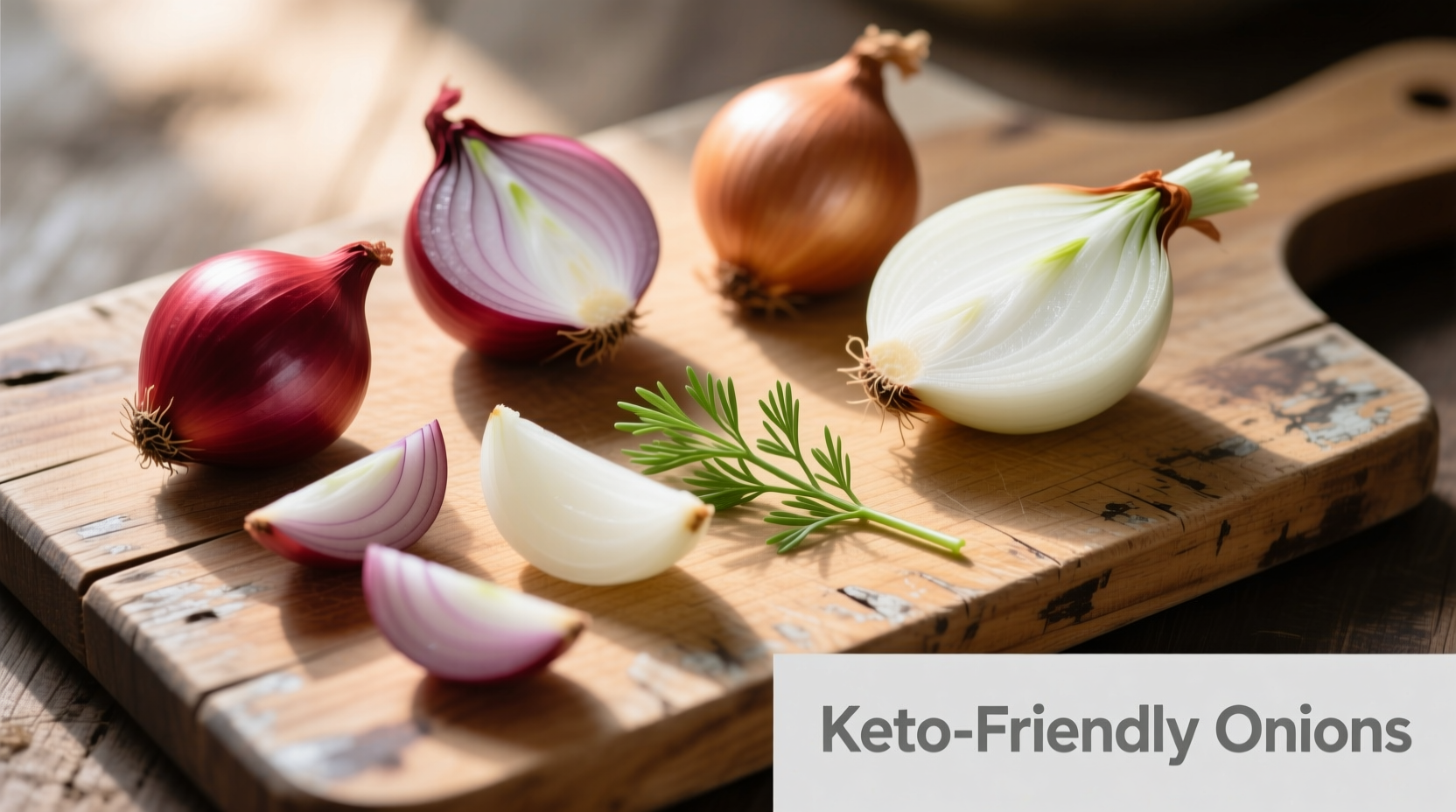Yes, onions can be keto-friendly in moderation. One medium onion contains approximately 9-12g net carbs, which fits within daily keto limits (20-50g) when portion-controlled. Red, white, and yellow onions vary in carb content, with scallions being the lowest-carb option at just 1g net carbs per 100g.
Understanding Onions in Ketogenic Eating
When starting a keto diet, many people immediately question whether common vegetables like onions fit within their carb limits. The answer isn't simply yes or no—it depends on portion size, onion variety, and your personal carb tolerance. Let's break down the facts so you can make informed decisions without sacrificing flavor in your keto cooking.
Carb Content Breakdown by Onion Type
Not all onions are created equal when it comes to carb content. Understanding these differences helps you make strategic choices in your keto meal planning:
| Onion Type | Net Carbs (per 100g) | Typical Serving Size | Net Carbs per Serving |
|---|---|---|---|
| Scallions (Green Onions) | 1.8g | 100g (3.5oz) | 1.8g |
| Red Onion | 7.7g | 1 medium (110g) | 8.5g |
| Yellow Onion | 8.6g | 1 medium (110g) | 9.5g |
| White Onion | 8.9g | 1 medium (110g) | 9.8g |
| Shallot | 10.5g | 1 medium (25g) | 2.6g |
Data sourced from the USDA FoodData Central, the authoritative nutritional database maintained by the United States Department of Agriculture.
How Onions Fit Into Your Daily Keto Carb Budget
Most keto dieters aim for 20-50g of net carbs daily. With this in mind:
- Strict keto (20g net carbs): Limit to 1/4 medium onion (25g) per meal = 2-2.5g net carbs
- Moderate keto (30-40g net carbs): Enjoy 1/2 medium onion (50g) per meal = 4-5g net carbs
- Liberal keto (50g net carbs): A full small onion (75g) = 6-7g net carbs
Remember that cooking concentrates flavors but doesn't reduce carb content—100g of raw onion has the same net carbs as 100g of cooked onion, though cooked onion takes up less volume.
Practical Strategies for Using Onions on Keto
As a chef who's worked with both professional kitchens and home cooks, I've developed these practical techniques to maximize onion flavor while minimizing carb impact:
1. Use Onion Infusions Instead of Bulk Onions
Saute a small amount of onion (25g) in oil or butter, then remove the onion pieces before adding other ingredients. This transfers flavor without adding significant carbs to your final dish.
2. Prioritize Green Onions
With just 1.8g net carbs per 100g, scallions provide that distinctive onion flavor with minimal carb impact. Use them as garnish to add flavor without blowing your carb budget.
3. Combine with Lower-Carb Alliums
Mix small amounts of onion with lower-carb allium vegetables like leeks (3.7g net carbs per 100g) or garlic (9.5g net carbs per 100g but used in tiny quantities).
4. Measure Before You Cook
"A little bit of onion" is not precise enough for keto. Use a kitchen scale to measure exact portions—25g or 50g—so you can accurately track your carb intake.
When to Limit or Avoid Onions Completely
While onions can fit into most keto diets, certain situations warrant stricter limitation:
- Therapeutic keto for medical conditions: Those using keto for epilepsy management or certain neurological conditions often limit to 10-15g net carbs daily
- Initial keto adaptation phase: During the first 2-4 weeks, some people restrict carbs more strictly to accelerate ketosis
- Individual carb sensitivity: Some people exit ketosis at higher carb thresholds than others
Keto-Friendly Onion Alternatives
When you need to minimize onion consumption, these alternatives provide similar flavor profiles with fewer carbs:
- Asafoetida (hing): A pinch provides onion/garlic flavor with virtually zero carbs (used in Indian cuisine)
- Chives: Only 1.9g net carbs per 100g with similar flavor profile to onions
- Radish greens: Mild onion-like flavor with just 1.7g net carbs per 100g
- Onion powder: Use sparingly (1/4 tsp = 0.3g net carbs) for concentrated flavor
Real-World Application: Keto Cooking Tips
From my experience teaching home cooks professional techniques, here's how to incorporate onions strategically:
For soups and stews: Use 50g of onion at the beginning of cooking, then remove before serving. The flavor infuses the broth without adding carb-heavy pieces to your final portion.
For stir-fries: Cut onion into larger pieces that you can easily pick out after cooking, or use primarily green onions which have lower carb density.
For salad dressings: Blend a small amount of raw onion with vinegar to create a flavorful base, then strain out the onion solids before using.

Tracking Your Onion Consumption
Many keto dieters fail by underestimating "hidden" carbs in flavoring ingredients like onions. To stay on track:
- Track onions in your carb counting app just like any other ingredient
- Pre-measure onion portions when meal prepping
- Consider onions part of your daily vegetable allocation, not a "free" ingredient
- Be mindful that restaurant dishes often contain more onion than you'd use at home
Final Thoughts on Onions and Keto
Onions absolutely have a place in keto cooking when used mindfully. Rather than eliminating them completely, develop a strategic approach that allows you to enjoy their flavor while staying within your carb limits. Remember that keto is sustainable long-term only when it includes foods you enjoy—learning to incorporate favorite ingredients like onions in moderation makes the diet more enjoyable and maintainable.











 浙公网安备
33010002000092号
浙公网安备
33010002000092号 浙B2-20120091-4
浙B2-20120091-4